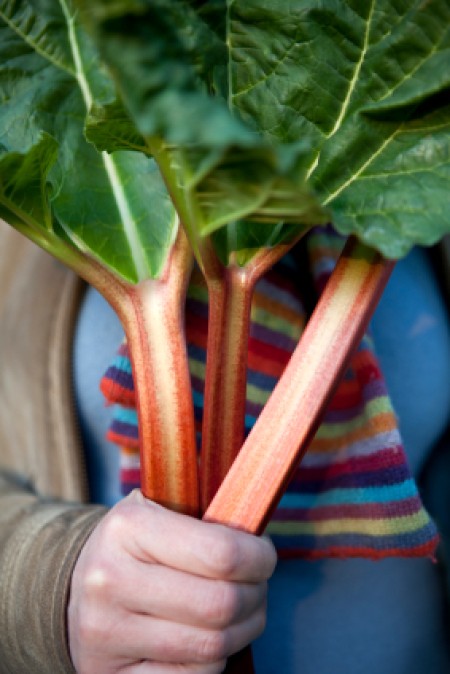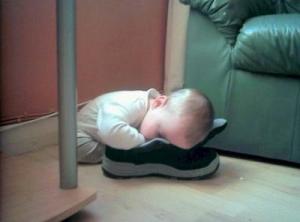 If you enjoy cooking with rhubarb, it's worth making space for a few of these plants in your garden. Although the tart flavored stalks are traditionally used like a fruit for pies, jams, and jellies, rhubarb is actually a long-lived perennial vegetable. With just a minimal amount of effort and care, an established plant will happily provide you with a crop of tasty stalks and attractive foliage for many years.
If you enjoy cooking with rhubarb, it's worth making space for a few of these plants in your garden. Although the tart flavored stalks are traditionally used like a fruit for pies, jams, and jellies, rhubarb is actually a long-lived perennial vegetable. With just a minimal amount of effort and care, an established plant will happily provide you with a crop of tasty stalks and attractive foliage for many years.
Propagation: Rhubarb is usually propagated by planting "crowns" (divisions of the roots that contain buds for new plants). If you neighbor doesn't have some extra plants to share, crowns are easy to obtain at nurseries, garden centers, or through mail order (or online) catalogs. Two to three plants will usually provide plenty of stalks for the needs of an average family.
Where to plant: If you take the time to prepare your planting site ahead of time, established plants will reward you handsomely for possibly decades into the future. Because rhubarb is a long-lived perennial, it's best to set aside a large, sunny, out-of-the-way spot in the garden where it will be free to grow without interfering with annual vegetable crops. Rhubarb is a heavy feeder and grows best when planted in fertile, well-drained soil with a pH of 6.0-6.8. Work the soil to a depth of 24 inches before setting in the crowns so roots have plenty of room to expand.
How to plant: Plant rhubarb in early spring. For each crown, dig a hole 2 feet deep and 2 feet wide. Space each hole 3 feet apart in all directions. (Some varieties are larger and may need even more space). Back-fill the hole to a depth of 12 inches with equal part soil and compost or well-rotted manure, plus 1/3 cup of 10-10-10- fertilizer.
Place one crown in each hole so that the plant buds sit 3-4 inches below the soil surface. Tamp the soil firmly around the roots, and fill the remainder of the hole with equal parts compost and topsoil. Mulch around each plant to conserve moisture and protect roots.
Feeding: Work a balanced (10-10-10) fertilizer into the top few inches of soil around the shoots at the first sign of growth each spring.
Division: Older plants can become crowded and should be divided every 4 to 5 years or when they start to exhibit spindly growth. This is best done in the early spring. Use a sharp spade to cut down through the center of the plant. Cut the roots of the removed portion into several parts, each of which should have one to three buds. Plant them as you would crowns.
Harvesting: Rhubarb plants are usually mature enough for harvesting a few stalks the second year after planting. Stalks are ready to pull when they are 12 to 18 inches long. Young stalks with the deepest red color usually have the best flavor, although some varieties produce only green-colored stalks. Harvest the stalks by twisting them off near the base (cut stems bleed and encourage disease). Rhubarb leaves should never be harvested for food as they contain high amounts of oxalic acid, which can be poisonous.
To maximize production, remove seed spikes as soon as they form to keep them from diverting nutrients from the stalks. Stop harvesting in early July to give plants time to build up food stores for next season.
My husband wants to plant more rhubarb this year. However the major plant companies we usually deal with (Park Seed, Burpee, etc.) are out of the crowns. I can find rhubarb seeds many places, but not the crowns. Can anyone help me out?
By Mary W.
Go to freecycle.org and sign up with your Yahoo. account. This is a place where you can post what you are looking for (rhubarb crowns) or post any thing you want to give away.
Today is July 23, and just yesterday I was given some rhubarb to transplant, I have planted it in full sun, and have spaced the root out some. My question is today, just 1 day later, my rhubarb is limp looking, and I'm not sure if it is going to make it. Can you tell me if there is anything that I can do to keep it alive and growing or should I just cut down the stalk's that I do have and hope for more next year?
Keep it nice and moist, watering it thoroughly every other day. Rhubarbs have heavy leaves, and it's asking a lot for a transplant to hold up as if everything's a-ok. Just pamper it this year, and it'll come back better than ever next year.
I agree with Beth, but I would like to add a tip my grandfather gave me that still works today, water it with a bottle of fizzy lemonade for the first few days after transplanting, not sure how it works, but it also works for houseplants in need of TLC, and even cut flowers!
After that water it with the rinse out water from your used cartons of milk. The best, cheapest, and most effective fertilizer I have ever used!
Most plants go 'limp' for a day or two after transplanting it's a shock to their systems. As said, they should pick up. My son and his wife moved into a house they had just bought around two years ago and there was a bit of a vegie garden up the back which had rhubarb and silver beet growing in it.
Fresh transplants in full sun should be shaded for a few days to get used to the yard. Then gradually remove the shade, keeping the sunnyiest part of the day the last time to be shaded.
How do you plant and maintain Rhubarb? What kind of soil do they like? Sun or shade?
Hardiness Zone: 5b
Carol from Nebraska (Southern)
You can start rhubarb from seed, from potted plants, or from root divisions that contain one or more buds.
Site Selection:
Planting:
Maintenance:
Harvesting:
Hi Carol,
When you plant Rhubarb, plant it in full sun after you work the soil with either compost or a good organic fertilizer. It will come back year after year, especially if you work into the soil, compost or fertilizer every spring. When harvesting the Rhubarb, take the very colorful leaves off the stalk and lay then under the plant. This is a great way to keep feeding the plant all summer.
Carol,
Ragteller is right, full sun, lots of compost - any cow manure in in southern Nebraska? Use that after the crop is finished in the fall. I cover my patch with it & then leaves on top of that in in fall.
Don't use the rhubarb the first year after planting new plants or transplants, allow to establish. ALWAYS put the cut leaves back around the plants after PULLING up the stock from the ground. Some think you should cut the stock off from the plant. Pull it up from the ground, only one stock at a time, and don't pull all from one plant. It will come away from the plant very easily, should look like a stock of celery (curved) but a pale pink...
Have had ours for over 30 years now.
Cheers
D. in N. S., Canada
According to Ellen's response...the rhubarb will never come up. The hole, yes, should be about 1.5 feet deep but the crown should be planted so that it will only be between 1 and 4 inches below the surface of the soil. I prefer 1 inch.
When dividing a rhubarb the roots will be quite long...that even a 1.5 foot hole might not be deep enough. I remember my grandpa digging out some of his rhubarb plant for me and he placed the pieces in a large garbage bag to transport them here.
New plants, something is eating holes in the leaves and not being very wise with rhubarb, my first try. Help

I need some advice regarding rhubarb. Firstly my stalks are well over 10 inches but still green, should they be red to eat? Secondly one of my bushes is seeding on top. Should I pull this bush out or just cut the top off. Thanks for your answers in advance.
By Phil
Something is eating the leaves on my rhubarb, but I can't determine what it is.
Hardiness Zone: 5a
By Tall Boy from Louisville, KY
What's causing my rhubarb to be stringy? What can I add to my rhubarb's soil to produce a more tender plant? Thanks.
Hardiness Zone: 4a
By stephanie from Anchorage, AK
Rhubarb should not he harvested until the second season after planting and then only for 1 to 2 weeks. Harvesting can be increased to 1 to 2 months by the third season and after that, plants can be harvested as often as you prefer.
Our rhubarb plant has "gone to seed"; do we cut this off or leave it as it is? The rhubarb was growing fine then all of a sudden it grew this huge globe shaped head on one of the stalks. It burst open and, hey presto, seeds.
By Ruth G